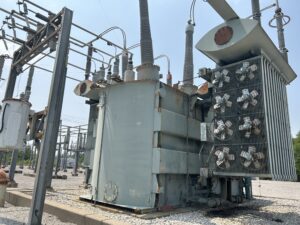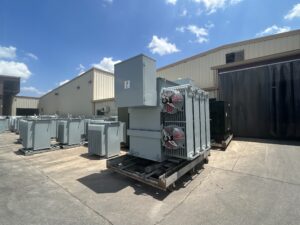By Mark Stone, Training Manager
We spend millions of dollars on our electrical systems, and most spend thousands annually trying to maintain that system. I want to talk to you about doing something that won’t cost you a dime and only some of your time. Doing a visual transformer inspection. That’s right, going out and just walking around your transformer or that substation looking at all the equipment.
So, what exactly are we looking for when we do our visual inspections? Of course, the easiest thing to spot is a leak that shows oil leaking. The one thing we must remember is that not all leaks will show oil. If the leak is above the oil level, we shouldn’t see any oil, but the concern now is that we are introducing atmosphere into our equipment. What is in the atmosphere? Moisture, Oxygen, and other contaminants can prematurely age our equipment. So we must do our best to prevent and repair leaks as soon as possible.

So, how do we tell if we have a leak that isn’t showing any oil? We have to look at the pressure/vacuum gauge. As the oil heats up, it will expand, and as it cools, it will contract, so if we have a good, sealed piece of equipment, we should have pressure or a vacuum. But, if you come across a pressure/vacuum gauge that is at “0” don’t panic. You might have just caught it as it’s going from pressure to a vacuum or vice versa. Come back and look at it when the ambient temperature has changed, or the load
might have changed. This would make the equipment run hotter or cooler and would make the gauge change. If it doesn’t

change from the “0” there is a good chance you have a leak above the oil level. Anything to the right of the 0 is pressure.
Our next concern should be the paint condition of the equipment. Believe it or not, the paint is there to help cool the equipment. When it chips, flakes, and rust starts to develop, it will cause the equipment to run hotter than it should. Most of us have probably gone up to
a transformer and touched it,
and when you pulled your hand away, it had a chalky film on it; this is normal from being out in the atmosphere all the time. But once the paint starts to peel, chip, and rust.
When performing a visual inspection of the paint, here are four issues to look for:
Caulking – Caulking is a white film that develops on the paint caused by exposure to sunlight.
Cracking – Cracks in the paint are usually caused by the paint hardening and becoming brittle. Temperature changes can also cause cracking as the metal expands and contracts.
Peeling – Peeling is usually caused by moisture accumulating under the paint, causing it to flake.
Rust – As the metal deteriorates, it will start to rust (ASTM D610-08 Rust Guide). Rust will eventually cause pinholes and leaks.

We must make sure that we inspect in between radiators. The individual radiator tubes are where the thinnest metal on the transformer is located. It’s also very important to look around the gasketed area like the butterfly valves on the radiators and the inspection plates. Also, you want to look at the welded areas and gauges. When it comes to leaks and paint
chipping and peeling, these areas need to be looked at very closely. The whole piece of equipment needs to be inspected, but these are the locations that we need to spend a little more time on.
If you have an active leak and you can’t see oil leaking out of the transformer, double check the pressure/vacuum gauge, and if it is at “0” and you can’t find the leak, it would be good to do a pressure test. This will put a couple of pounds of pressure into the tank and then put a product called snoop, it’s like soapy water, and it will bubble up where it is leaking, and then repairs can be made.
Summing It All Up
In conclusion, conducting thorough visual transformer inspections is a cost-effective measure that can significantly contribute to the longevity & optimal performance of your electrical system. By dedicating some of your time to visually examining the equipment, you can detect and address potential issues before they escalate into costly problems. Keep a keen eye out for oil leaks, as they not only indicate immediate concerns but also serve as gateways for moisture, oxygen, and contaminants that can compromise your equipment’s lifespan.
Additionally, pay attention to the condition of the paint, as chipping, flaking, and rust can hinder proper cooling causeing the equipment to overheat. Remember to inspect critical areas such as radiators, gasketed areas, welded regions, and gauges for leaks and paint deterioration. In cases where an active leak persists without visible oil leakage, utilize pressure testing and the application of a product like snoop to pinpoint the exact source of the leak for timely repairs. Investing a little time in visual inspections can go a long way in safeguarding your electrical system and optimizing its performance, without burdening your budget.
To get a more in depth view of an inspection walk through watch the video below!

Want to take a step further and physically maintain your transformer? Check out our other articles below to learn more!
How Often Should I Pull a Transformer Oil Sample?
Transformer Oil: Everything You Need to Know
4 Things You Need to Know About Transformer Oil
5 Questions on Transformer Grounding
Visit our YouTube Channel to stay up to date on our industry related content!